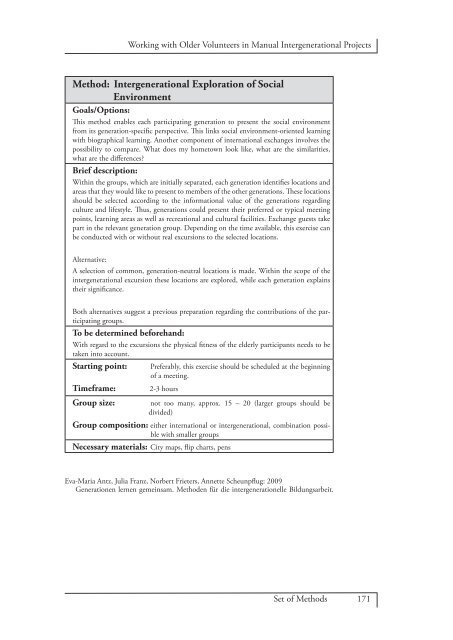Download - TRAMP - Arbeit und Leben DGB/VHS
Download - TRAMP - Arbeit und Leben DGB/VHS
Download - TRAMP - Arbeit und Leben DGB/VHS
Create successful ePaper yourself
Turn your PDF publications into a flip-book with our unique Google optimized e-Paper software.
Working with Older Volunteers in Manual Intergenerational Projects<br />
Method: Intergenerational Exploration of Social<br />
Environment<br />
Goals/Options:<br />
This method enables each participating generation to present the social environment<br />
from its generation-specific perspective. This links social environment-oriented learning<br />
with biographical learning. Another component of international exchanges involves the<br />
possibility to compare. What does my hometown look like, what are the similarities,<br />
what are the differences?<br />
Brief description:<br />
Within the groups, which are initially separated, each generation identifies locations and<br />
areas that they would like to present to members of the other generations. These locations<br />
should be selected according to the informational value of the generations regarding<br />
culture and lifestyle. Thus, generations could present their preferred or typical meeting<br />
points, learning areas as well as recreational and cultural facilities. Exchange guests take<br />
part in the relevant generation group. Depending on the time available, this exercise can<br />
be conducted with or without real excursions to the selected locations.<br />
Alternative:<br />
A selection of common, generation-neutral locations is made. Within the scope of the<br />
intergenerational excursion these locations are explored, while each generation explains<br />
their significance.<br />
Both alternatives suggest a previous preparation regarding the contributions of the participating<br />
groups.<br />
To be determined beforehand:<br />
With regard to the excursions the physical fitness of the elderly participants needs to be<br />
taken into account.<br />
Starting point: Preferably, this exercise should be scheduled at the beginning<br />
of a meeting.<br />
Timeframe: 2-3 hours<br />
Group size: not too many, approx. 15 – 20 (larger groups should be<br />
divided)<br />
Group composition: either international or intergenerational, combination possible<br />
with smaller groups<br />
Necessary materials: City maps, flip charts, pens<br />
Eva-Maria Antz, Julia Franz, Norbert Frieters, Annette Scheunpflug: 2009<br />
Generationen lernen gemeinsam. Methoden für die intergenerationelle Bildungsarbeit.<br />
Set of Methods 171


